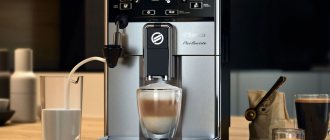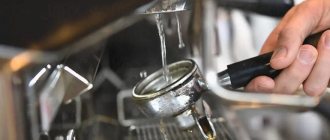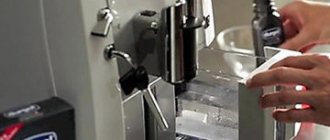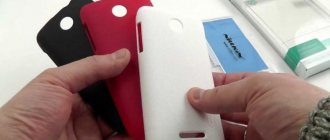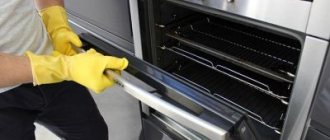Today there are a lot of products designed for descaling. Despite the list of functions and versatility of use, it is not always possible to choose exactly the substance that will cope with multi-layer deposits. Where does scale come from?
There are a couple of reasons to clean your appliances:
- Electricity consumption increases due to increased heating time.
- Disconnecting the device from the network in heating options.
- Reduced taste and quality of water.
- The device stops working.
Where does scale come from?
Scale is hard build-up and sediment that appears due to the deposition of chemical elements (magnesium and calcium salts) when exposed to high temperatures (1000). In other words, when water (H2O) boils, the salts are split into two elements - sediment, the one we see at the bottom of the kettle, and carbon dioxide, which evaporates as steam.
In every kettle, sooner or later scale forms - salts of compounds inherent in hard water.
The reason for all this is water hardness. The higher the hardness level, the more minerals in the water. There are 4 degrees: 1 – water quality is normal, 2 – more or less, 3 – poor example of water, 4 – very hard water. Knowing the level of hardness in your home, you can understand exactly how often you need to carry out preventive work.
Scale has a detrimental effect on everything:
- Excess scale on all water heating devices leads to their breakdown.
- The taste of water changes beyond recognition and has a specific smell.
- Increases energy consumption. The device needs to work longer, since it cannot heat the water faster due to plaque build-up.
Scale and rust inside ordinary teapots - metal or enameled - also does not bring joy.
To combat scale, it is important to know what anti-scale products can be used, how to make cleaning more effective and which drugs will 100% cope with the task in a given case.
Why does it work
Arina Piskareva
Laboratory employee, Department of Bioengineering, Moscow State University
Scale is mainly composed of calcium and magnesium carbonate. When interacting with citric, acetic, orthophosphoric or other acid, sparingly soluble carbonates of alkaline earth metals are converted into readily soluble salts. For example, acetates. Therefore, acidic substances are effective in the fight against scale, and to enhance the reaction they need to be heated.
Soda, when interacting with water, produces carbonic acid molecules, which, in turn, react with insoluble calcium and magnesium carbonates, turning them into soluble bicarbonates. And they are easily washed off with water and removed with a sponge.
How to get rid of scale
Knowing who we are dealing with, we can safely begin cleaning the devices and use various methods for this. There are many options for removing this disease, both special and traditional. But first you need to note what not to do:
- Remove sediment mechanically. You will not achieve a positive result, but you will spend a lot of effort and time, and you will also damage the device or deform it. The mechanical method involves using sharp improvised means for cleaning (knife, metal sponge, various types of scrapers).
- Do not use aggressive chemicals. Various kinds of purchased drugs are similar in composition to “Belizna”. You will see the result, but you will not be able to remove the unpleasant pungent odor or completely wash off the product.
- Do not use abrasive objects to scrub off plaque. The scratched surface will be even more exposed to scale.
Before using any method, read the instructions in detail so as not to harm the equipment.
Important! It doesn’t matter what cleaning method you choose, if the equipment is very expensive or requires special care, you should consult a specialist or consult a service center about this.
Antiscale safety level
Some users are afraid to use lime dissolving cleaners because they have a “nuclear” composition. Of course, any chemicals are harmful, since the acids they contain can corrode even metal elements.
To ensure safety when using the cleaner, it must be used strictly according to the instructions, maximum once a quarter. If you follow the basic rules and dosage standards, no negative effect will occur.
Some housewives have adapted to using sodium carbonate (soda ash). This is a good option, but it doesn’t always help.
Folk remedies for cleaning
It is no secret that in the good old days there was not such an abundance of special means for cleaning and removing plaque, and certainly not a lot of money to constantly update everything that was damaged by scale. All available methods were used, those that are available at home, and those that are not very expensive. We experimented and found a couple of proven methods for keeping devices clean, as they say, the methods came from the people.
Old scale in a kettle can be cleaned using a combination of many methods.
Lemon acid
A universal product, it can be used both for a kettle and for a washing machine or dishwasher. And not only. The calculation is made as follows: 2 sachets of citric acid are dissolved in 1 liter. water. Pour the product into the device and bring to a boil. They are left to cool, and then thoroughly washed and run “in vain” (just water, not for use - to eliminate the smell and residues).
If after one use you do not like the result, the procedure can be repeated.
Method for a plastic electric kettle and ordinary kettles.
You can also use just lemons as a substitute. Cut a small lemon into pieces, add water and do the same manipulations as with citric acid. As a pleasant bonus, a charming citrus aroma will be felt in the apartment.
Vinegar
Quite an aggressive method for descaling. But very effective. For 500 ml. dilute half a glass of vinegar (9%) or two tablespoons of vinegar essence (70%) with water, pour into a container where plaque is supposed to be removed. Bring to a boil, keep on the heat for a couple of minutes, turn off and leave until completely cool. This process should be monitored for peeling off growths. After the time has passed, wash and dry the device.
Quick and high-quality cleaning of dishes without harm to health and the use of “chemicals”.
Important! When choosing the vinegar method, wear a protective mask and open a window to protect yourself from the fumes - the smell will be very pungent and specific.
Soda
The most gentle method is to use soda. Pour soda (1 - 2 tbsp) into half a liter of water and mix. Pour into a tank or container with scale and boil for half an hour. Let it cool, wash thoroughly and wipe dry. For prevention, we start the boiling process with ordinary plain water. If necessary, repeat the process.
Soda is an excellent remedy for metal and enamel teapots.
Soda
Everyone already knows about the amazing properties of carbonated drinks (Coca-Cola, Sprite, Fanta). And it really works. Take your favorite drink and release the gas from it. Pour into a container and boil. Let it cool and rinse.
Important! If the device is light, it is best to use a sprite, as Coca-Cola can leave streaks.
It is recommended to use Sprite, as Cola and Fanta can leave their own tint on the dishes.
Pour water and add 2 tablespoons of soda. Put on gas and bring to a boil. Keep it on the stove for half an hour. Then drain the solution and immediately pour water again with the addition of citric acid in the amount of one tablespoon. Boil for half an hour. Drain. Pour water a third time with the addition of half a glass of vinegar and perform the same procedures. At the end, leave it until it cools completely, wash the container and use it.
This method is very harsh in relation to scale, but it is better not to use it often. It is better to monitor your equipment and utensils and not give scale a chance to multiply using such methods.
Additional Information. When there is a lot of scale and the case seems to be not an easy one. A three-phase cleaning process will help.
Special means
The name speaks for itself - these are products that were invented specifically for removing plaque and scale. There are many of these in household chemical stores. And there are even more manufacturers. The choice is yours, go buy or use traditional methods. When choosing, it is important to understand that a beautiful cover on the bottle, a high price, a famous brand and advertising does not mean that this is the best descaler.
The stores offer professional plaque removal products.
Universal means
Universal products include products that, by their nature, can be used for cleaning any appliance (kettle, iron, dishwasher, washing machine, etc.). Among those known to us, a very popular one is anti-scale. This is a universal tool. Release form: powder. Russia is a producing country.
Floating deposits are softened and easily cleaned from the disc and disc surfaces.
It can be used for all devices known to us:
- Washing machine. Instead of powder, two bags of anti-scale agent are poured into the cell, the temperature is set to 400C, and the wash is started “idle” for approximately 45 minutes.
- Iron. A wide baking sheet is placed on the stove, two slats are placed on the bottom on which the iron is placed. Pour anti-scale into a baking tray and pour boiling water over it. The solution should cover half of the sole. Under no circumstances should you reach the plastic housing. Leave for a couple of hours. For a better effect, you can turn the burner to a low heat setting.
- Dishwasher. We dilute anti-scale agent in a container and place it on a wire rack. We start the washing cycle.
- Coffee machine. We make the descaling agent according to the instructions. We carry out cleaning depending on the type of coffee maker.
Interesting fact. The main component of the anti-scale agent is diluted vinegar essence (70%).
After using the products at home, it is correct to boil the water 2-3 more times.
For washing machines and dishwashers
If you do not believe in the miraculous power of folk methods, then you can use special methods.
When you go to a household chemicals store, the most important thing is to have a “cold approach.” You know what exactly you need, what your situation is with dishes or appliances, and what budget you are counting on. Don’t give in to the temptation to buy the cheapest because there are discounts, or the most popular because you saw an advertisement, or the new one presented by a consultant.
For any equipment there are special products from the equipment manufacturer.
Read the instructions carefully, maybe not for all of them, but a few definitely need to be read. Highlight what they have in common and how they differ from each other.
For descaling coffee machines
Often factory methods are at the level of folk ones, but they are used because they are simple. For example, tablets for a coffee machine. I put it in, started it up and that’s it.
If the coffee machine reservoir is removable, remove any remaining deposits under running water.
This approach has the right to life. Some people want to bother with cleaning, others don't. Therefore, coffee machine manufacturers produce tablets, as well as a variety of descaling products and concentrates. Popular solutions for removing plaque and sediment are from Bork, Saeco, Krups, and tablets from Bosch Siemens. Buy only original products and read the instructions carefully.
To remove limescale from an iron
A special product for irons is a pencil. It is designed to clean the soleplate of the iron from scale. The inside of the iron can be cleaned with universal products.
After the procedure, rinse the iron reservoir with running water and wipe the sole with ammonia or nail polish remover.
To descale a kettle
Antiscale is the best remedy for scale. Just a godsend for equipment and utensils. And an electric kettle or an ordinary kettle is also in those rows.
Antiscale is designed to remove limescale from kettles and other appliances.
Comparison table of characteristics
In order to compare the presented products, we recommend taking a look at the table with their characteristics.
| Means | Country of Origin | Volume (ml) | Release form | Price, rub) |
| De'Longhi EcoDecalk | Italy | 500 | liquid | from 729 to 2360 |
| Topper | Germany | 250 | liquid | from 240 to 540 |
| Bosch TCZ8002N | Germany | 3 pcs | pills | from 950 to 1168 |
| Jura for decalcification | Germany | 6 pcs | pills | from 890 to 1480 |
| Filtero | Germany | 10 pieces | pills | from 475 to 1460 |
| Jura for cleaning coffee machines | Germany | 6 pcs | pills | from 890 to 1480 |
| Bosch Descaling | Germany | 3 pcs | pills | from 587 to 1200 |
| HG | Netherlands | 500 | liquid | from 286 to 427 |
| Top House | Germany | 250 | liquid | from 269 to 390 |
| Frau Schmidt Antiscale tablets | France | 10 pieces | pills | from 229 to 440 |
| Philips Saeco liquid | Germany | 250 | liquid | from 750 to 829 |
| Mellerud | Germany | 500 | liquid | from 424 to 520 |
| Nivona NIRK 703 | Germany | 500 | liquid | from 1290 to 1490 |
| Topper tablets | Germany | 40 pcs | pills | from 1290 to 1490 |
| HG Universal product | Netherlands | 500 | liquid | from 286 to 487 |
How to get rid of scale in a kettle
The kettle probably suffers the most from scale, because its immediate task is to boil water. The more you use it, the more often it needs to be cleaned. And if you have very hard water at home, how to remove scale from an electric kettle is a hot topic.
Plaque, scale and sediment in an electric kettle or a regular kettle react most to acid-containing solutions and preparations.
At home it is: vinegar, citric acid, soda, soda. Brine, yogurt, skins of sour apples and potatoes also do a good job of removing sediment.
There are plenty of ways to clean a kettle at home.
The methods of application are very primitive. We take any product, combine it with water, pour it into a kettle, put it on fire, bring it to a boil, set it aside, cool it, wait time, wash it and wipe it off.
You can clean the electric kettle with a universal anti-scale agent.
There are many methods for removing scale, but a kettle is not a piece of equipment, but a piece of utensils. Therefore, cleaning once every two weeks in any convenient way is better than looking for more stringent measures to destroy scale after six months.
Advice from experienced housewives
Do you often have to descale?
Constantly! Periodically
- To prevent scale, you need to use filtered liquid. And when using tap water, let it sit for several hours.
- Water poured into a container should not be boiled more than once.
- To prevent the appearance of powerful scale, a simple manipulation is performed: when boiling water, pour 1 tbsp into a container once a month. l. citric acid.
- By using simple methods for cleaning household appliances, you can permanently get rid of problems with scale accumulation. If you remove solid deposits in time, you can prevent their accumulation on the walls.
As you can see, there is nothing complicated in caring for household appliances. You just have to choose the right cleaning agent, taking into account the material and model of the device.
Descaling your coffee machine and coffee maker
If you love coffee and you have a coffee machine at home, then sooner or later it also needs to be cleaned of scale and sediment. It doesn’t matter what brand it is, you should always clean it, be it capsule, geyser, pod or carob.
It is recommended to clean the coffee machine once every three months, because in addition to hard water, coffee oils also accumulate in it. How to know when it's time:
- coffee takes a long time to prepare;
- the drink flows out more slowly, the stream has become thinner, scale has formed on the tube;
- the taste of the coffee has deteriorated and an aftertaste has appeared;
- the smell of coffee has changed;
- the coffee machine began to “abuse” energy;
- white and light gray impurities can be traced in the drink;
- previously unknown sounds are heard from the operation of the device;
The coffee machine can be cleaned in different ways: with improvised means or purchased ones.
In everyday life, this is descaling with vinegar or citric acid.
Steps for descaling with vinegar:
- Make a solution in the ratio of vinegar to water (one to two).
- Pour this mixture into the water tank.
- Turn on the coffee maker.
- Wait until it warms up and reaches maximum temperature (about 15 minutes) and turn it off.
- Leave for 10 hours for the product and scale to interact.
- Pour the solution into the sink and wash the equipment very thoroughly several times.
- Prepare a couple of cups of coffee to remove all the remaining residue from the coffee maker.
Advice! Don't skimp on water and make ten cups of coffee instead of two to kill the smell and taste of vinegar.
Steps for descaling with citric acid:
- Combine two packs of citric acid (40 g) with water (1 l) and fill the coffee machine.
- Turn it on, and after boiling, turn it off.
- Wash all parts in this solution.
- Repeat all steps several times.
- Make a couple of cups of coffee to cleanse the residue.
Traditional methods are wonderful, but not everyone trusts them. Each coffee machine manufacturer offers descalers of one brand or another.
The products come in tablet form and come in bottles. It all depends on the brand and type of car.
You can also use a universal product - anti-scale agent - for cleaning the coffee maker.
It should also be said that many coffee machines have a self-cleaning function. Here you also need to carefully read the instructions. Each model has its own nuances during self-cleaning. Although everyone has the same scheme - fill the tank with solution, press the “Auto-cleaning” button. The coffee machine will do everything itself.
How to descale a washing machine
Not every housewife can imagine her life without a washing machine, and if it breaks down, the thought that comes to mind is that it should have been descaled.
If we visually see plaque, sediment and growths in the kettle, we begin to clean it, but in the washing machine the heating element is hidden, and we don’t think that it needs such a procedure and will extend its life.
To remove scale from a washing machine, there are both traditional methods and special means.
You can also clean your car with a universal anti-scale agent.
Important! This product is available on the market from many manufacturers, so you need to read the instructions before use, since the dosage and methods of use may differ from each other.
Traditional methods include:
Citric acid is a good descaling agent. The procedure is as follows:
- One glass of citric acid, divided in half. Pour one part into the powder compartment, the other into the drum. Proportions based on a capacity of 5-6 kg. If the machine is automatic by 3-4 kg, the dose needs to be reduced.
- Select the most “hard” program, where the temperature is 700 – 900C. And run without underwear for two hours.
- At the end of the wash, use the rinse program.
Run a wash without laundry at maximum temperature, and then rinse again to be sure to get rid of the specific aroma.
Table vinegar is a very excellent anti-scale agent for washing machines. But it should not be abused, as it has a bad effect on some machine parts (rubber bands, gaskets, etc.). This is done like this:
- Pour one glass of vinegar (9%) into the detergent compartment.
- The machine operates at the highest speed and program duration, as well as high temperature.
- After 15 minutes the machine is paused.
- After an hour, resume washing and wait for the cycle to complete.
- Then turn on any program to rinse the car thoroughly.
- Wipe the drum body and lid inside with a weak vinegar solution.
Important! After any procedure, you need to open the drain filter and throw away any remaining debris and plaque.
What to do with limescale in your dishwasher
In order to eliminate problems with scale in the dishwasher, you can use advertised products (“Finish”, “Somat”), or you can also remember about traditional methods.
In the first case, start the machine, selecting the program with the maximum water temperature, place a plastic container with a professional solution for removing plaque and scale on the mesh.
In the second case, a good cleaning solution would be vinegar and soda. We put a glass of vinegar in the machine, start it, when finished, take out the glass and scatter soda along the bottom. Leave it overnight. In the morning we run a full cycle for rinsing and cleansing.
In addition to removing accumulated food debris, we recommend rinsing the filter with dishwashing detergent.
Excellent results can be seen after using borax for cleaning. The procedure begins with surfaces, they must be covered with a thin layer of the mixture, then left for 20 minutes, after which the program must be started with maximum heating. When finished, rinse the filter and start the machine again in idle mode.
If the above methods did not cope with the task, the best folk remedy for scale will help - a soda bomb. The procedure is as follows:
- Mix 2 cups of soda ash (you can also use baking soda) with hydrogen peroxide (3%). Add a teaspoon of washing powder for scent (optional).
- From the resulting paste we form balls of any size. And leave them to dry.
- When the balls have hardened, place them on the bottom of the dishwasher.
- We place containers with vinegar (two glasses) on the top grid.
- Let's launch the program and rejoice at our achievements.
Important! While the program is running, the machine may make sounds and hissing, do not be alarmed, this is normal.
Description of popular brands
| Brand name | Product type | Single dose | Mode temperature °C | Price | Reviews |
| "Cinderella" | Liquid, 250 ml | 250 ml | 40–50 | 33,10 ₽ | “I was pleased with the price and versatility. He copes with the task." Nikolay, Vologda |
| Scrubman | Bulk, 250 g | 250 mg | Not lower than 60 | 71 ₽ | “After “Scrubman” the heating element was as good as new, even the machine stopped making noise.” Oksana, Samara |
| Un momento | Liquid masterbatch 5x10 | 3 microdoses | 60 | 127 ₽ | “Un Momento” for the washing machine is excellent, very effective. Convenient format - no spills or spills." Olga, Moscow |
| "Chistoff" | Liquid, 1000 ml | Dilute with water from 1:2 to 1:10 | Not higher than 40 | 52 ₽ | “Inexpensive, large volume, but the smell is not very pleasant.” Anastasia, Voronezh |
Cleaning scale from an iron
When scale and deposits appear on the iron, it is noticeable from two sources: firstly, it is visible visually, and secondly, after ironing, things are damaged and stained. Then the moment comes to choose whether to buy a new one or clean it.
To remove scale from the inside of the iron, two proven folk remedies will help us: vinegar and citric acid. The procedure is as follows:
- One packet of citric acid is dissolved in water and poured into the iron.
- The iron is connected to electricity and heated, then the effect of citric acid is enhanced and the plaque goes away.
- Such manipulations need to be done a couple of times and only then turn on the steam function so that all the liquid evaporates.
- When the iron has cooled, wipe the soleplate with vinegar.
- Then pour clean water, turn on the iron and iron any unnecessary cotton fabric, using the steam mode.
Turn on the iron and release steam until all the liquid is used up.
I can clean scale inside and plaque outside with professional products. These are universal (cleaning only inside), special ones intended only for irons (removing scale and plaque everywhere), as well as pencils for cleaning the surface and holes in the sole.
Everyone knows how to use a universal tool, but how to use a pencil? The procedure is simple, since a pencil is used to clean the surface, only the sole of the iron is cleaned with it. Having turned on the iron and prepared the old unnecessary fabric, we rub the underside of the device with a pencil. Using the steam function, we iron the fabric, thereby cleaning the nozzles and soleplate of the iron.
If your iron has a self-cleaning function, you can use it to remove scale. Each model has its own nuances, and for everything to go well, it wouldn’t hurt to read the instructions for using the self-cleaning function again.
Important! No matter how many stages there are of turning on and off the iron during self-cleaning, it must be in a vertical position and above a container into which water will flow without warning.
Sooner or later you will have to descale your iron even when using a very high-quality device.
What to do to prevent scale
To ensure that scale and deposits appear on your dishes and equipment as rarely as possible, you need to follow some recommendations for prevention:
Iron:
- pour filtered and distilled water;
- Always leave the device in an upright position;
- After use, the water from the iron must be drained.
Washing machine:
- When washing, use only high-quality powders marked automatic;
- try to wash at low temperatures (up to 500C). Pre-soak very dirty items;
- For prevention, descaling should be carried out on an unplanned basis once a year.
Coffee machine:
- use filtered water;
- carry out cleaning once every three months for prevention;
- Do not mix special decalcification products with folk remedies.
The easiest way to descale a coffee machine at home is to use special products. Dishwasher:
- thoroughly clean the plates of food; scale deposits are most likely to accumulate on the residues in the drains;
- Always use dishwasher salt, it changes the composition of the water and prevents scale and limestone deposits.
Electric kettle:
- try to use filtered water;
- constantly pour out the remaining water from the kettle, do not leave a drop;
- Fill the kettle with new water each time;
- Do not wash surfaces with abrasive products; you will harm the kettle and yourself, because plaque will form on surfaces with microcracks faster.
